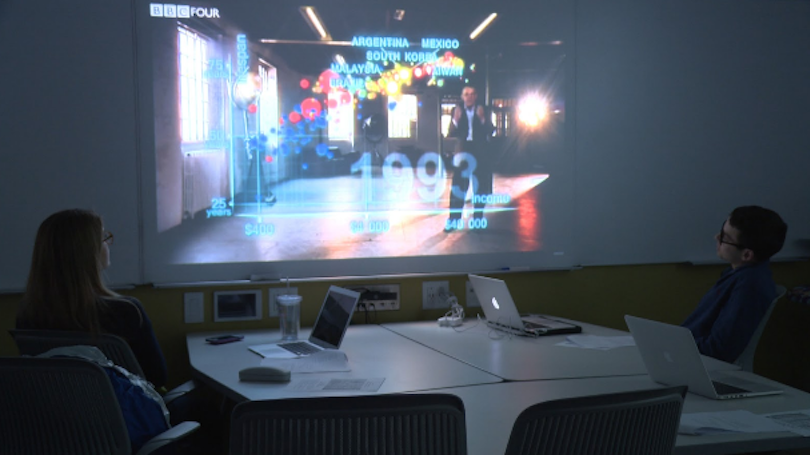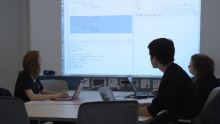

Too many discussions of ed tech focus on tools (like tablets, clickers, learning-management systems, smart boards, etc). More thought should be spent on the design of the classroom itself.
Two years ago we renovated an old computer lab into an active learning classroom. The idea was to make the room, Carson 61, into an incubator—to spark similar classroom redesigns all over campus.
As at many colleges, the classroom started out with fixed rows of tables, and tower computers. There was a clear front of the room, with a large fixed podium and a single projector.
In our redesign, we carted all that off and brought in moveable furniture, flexible lighting zones, about half a dozen projectors, and whiteboards on every wall—and not a single installed computer.
The old arrangement strongly suggested—and really only supported—interactions between student and instructor or student and computer. Now, as an active-learning classroom, the default arrangement is for students to work in teams—six team stations for up to 36 students. Technology in the room supports a video display for each team and the capability to share a display to any one or all seven projectors in the room. Although there is a “main” screen, the absence of a fixed podium allows flexible focus and instant presentations from anywhere in the room. Although you bring your own computer (or other device), the facility provides a video and audio system to video conference with guest speakers (on systems like Zoom and Skype).
We’re not alone in redesigning high-tech classrooms. Case Western Reserve documented its first- and second-year efforts to add two active-learning spaces and support faculty teaching in the space. Indiana University has a campus-wide Mosaic Initiative to encourage and support active and collaborative learning in all classrooms. McGill University has developed Principles for Designing Teaching and Learning Spaces to instruct and encourage others who strive to teach well in redesigned spaces.
We have learned some lessons in the past two years through faculty focus groups and by surveying students about their experiences teaching and learning in Carson 61. This evaluation has enabled us to adapt and hone the process of selecting, preparing and assisting instructors to teach in the room.
Here are a few lessons learned:
Supporting whatever computers that students and professors bring sounds flexible. In practice, the short transition times from one class to another are sometimes made shorter when the wireless software needs to be updated or audio settings need to be changed to play a video. There is a certain efficiency to walking into the room, logging in to your account, plugging in a USB or URL and starting class.

While we thought that having a video hook-up for each of the six teams might encourage some interesting interactions with multiple guests, logistically it is difficult to get more than one or two guests to join a class. We might ask at what point would having many guests be a better learning experience than having one or two? So far the smaller cameras at each group station are rarely used.
Lighting needs to be adjustable, in zones of possible for screen tasks and table tasks. The room needs to project intended sounds while dampening HVAC blowers, projector fans, and chatter.
Sometime the lowest tech is the most important—and is often forgotten. If you run out of markers, or the only erasers are filthy, frustration grows. Instructors and students need fresh markers and clean, effective erasers to focus on creating and synthesizing knowledge, not smudging it with their fist.
“I thought it was a great room setup, especially because it facilitates group learning,” one student wrote in the survey “It was also nice being able to write group work on whiteboards close to you. I would put classes in there that are made up of groups.”
A classroom can be feature-rich and highly flexibly, however this needs to be supported by course design, technical support, and ongoing evaluation. We set up an application process and support plan that started as a method to select courses for a highly-sought-after classroom, become an important first engagement with faculty who were interested in teaching in an active learning classroom.

Students and faculty tell us that this is all making a difference. Our hope is that this incubator classroom sparks course redesign, increases demand for active-learning spaces, and surges available funding for innovating classrooms.
One faculty member shared, “I had each team draft answers to discussion questions and then we would discuss each team’s answers with the entire class. By having their answers up on the screen, I could often scan and pick out some of the most interesting things that each group devised—which made for a better group discussion.”
One thing this innovator classroom has changed is that professors are speaking up about the rooms they need and letting us know when existing classrooms fall short. Looking ahead, the Carson 61 project has taught us that we must design, build, support the people, evaluate, and iterate ... forever.
This article first appeared on EdSurge on July 1, 2017.